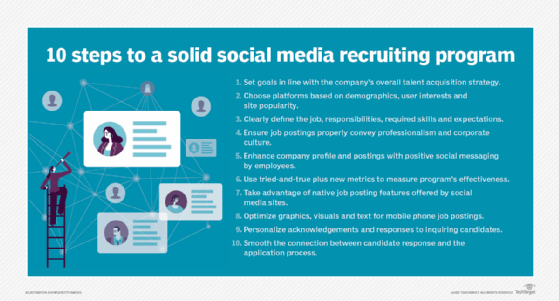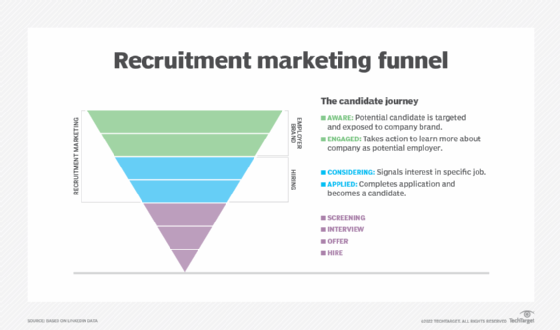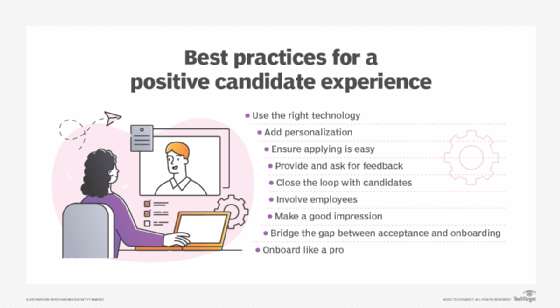Guide to developing social media recruiting strategies (original) (raw)
What is social media recruiting?
Finding the right talent is a top priority for most organizations and perhaps more important today than ever before.
Executives in one recent study said they believe a strong talent program is the greatest necessity for driving growth. More than three-fourths of executives responding to the "PwC Pulse Survey: Executive views on business in 2022" said hiring and retaining talent is their most critical growth driver -- well ahead of digital transformation and economic issues. Executives have good reason to focus on recruitment and retention of top talent; only about one-third of survey respondents expect talent shortages to ease in 2022. Consequently, a majority of the executives said they're "investing a lot" in hiring and retaining talent, including increased employee compensation and addressing labor shortages with improved processes. And, according to HR experts, more of that money is going to social media sites where recruiters can identify and engage potential hires.
Social media recruiting describes the use of social media platforms -- professional-oriented sites such as LinkedIn and general audience sites like Facebook and TikTok -- to identify, find, engage and vet individuals for hire. This HR practice is sometimes called social hiring or simply social recruiting. Whatever the term, social media has become the single most dominant method of recruiting today.
Why use social media for recruiting?
To identify, engage and recruit workers, job search firms and internal corporate recruiters now use social media as the primary approach to finding talent, rapidly surpassing more traditional recruiting practices like campus recruitment and worker referrals.
The "2021 Future of Recruiting Study" by social recruiting platform provider CareerArc found that the large majority of employers surveyed recruit talent through social and professional networks, topping a list of recruiting tactics that include employee referrals, job boards and job ads. Likewise, a large majority of job seekers surveyed use social media to search for relevant jobs, apply for jobs directly and engage with job-related content. That's not surprising, considering more than three-fourths of workers use social media on the job and nearly all of them personally use social media, according to research by job site Zippia.
Recruiters use social media to reach more people and a broader pool of candidates, including passive candidates, more quickly and at lower cost than traditional recruitment strategies such as classified ads and job boards. A host of recruitment tools offered by the social media platforms enables recruiters to conduct targeted searches efficiently and effectively.
"Social media offers an additional medium by which to interact with candidates who may not be available or active on more traditional sourcing methods," said Daniel Young, a senior partner at executive search firm WittKieffer. "LinkedIn, in particular, allows for a quick and easy interface to message with candidates and to get a snapshot of a career. Utilizing social media for me personally ensures that my clients are getting a comprehensive look at the marketplace and that we are meeting candidates where they want to be met."

Stepping up recruiting efforts on social media sites.
Social media recruiting strategies
Despite the prolific personal use of social platforms, online recruiting requires a lot of work and a fully formed strategy to produce the best results. Recruiters must tweak conventional strategies to suit digital platforms, commit to the ongoing use of social media to build communities and stay relevant even when they're not actively filling jobs. They also need to be extra thoughtful, because any missteps online can be quickly amplified, thanks to the very nature of social networks. To help ensure a successful social media recruitment strategy, following is a compilation of practical steps offered by experts.
1. Set goals
Social media recruiting isn't an isolated task, nor should it be done casually. Instead, it should be part of an overall talent acquisition strategy that involves hiring managers, HR staff and professional recruiters working together to ensure that the social media recruiting efforts are coordinated and effective.
As with any HR task, a successful social media recruitment strategy should have measurable objectives based on the organization's staffing needs and talent strategy. Many of the recruitment goals that were relevant before the advent of social media are still applicable today. Those goals and objectives include the following:
- boosting the number of quality candidates;
- streamlining the recruitment process;
- lowering the cost of recruitment per hire; and
- improving engagement with prospective candidates.
Social media recruiting also enables a level of creativity that traditional recruitment tactics, such as newspaper ads, didn't easily support. "It doesn't hurt to experiment," said Matthew Deneroff, vice president of IT staffing agency Robert Half Technology. "Creativity is ultimately rewarded in the recruiting business."
2. Choose the right platforms
Social sites can attract different demographics based on age and interests, and they also fluctuate in popularity -- all of which should be considered when formulating an effective social media strategy. Tips for choosing the best social media platforms for job recruitment include the following:
- Consider demographics. Pew Research Center's "Social Media Fact Sheet" revealed that the largest percentage of adults use Facebook versus Instagram and LinkedIn. But upon closer examination, those between the ages of 50 and 64, which would include workers with several years of experience, are more likely to use LinkedIn instead of Instagram, while those between the ages of 18 and 49, which would include college graduates and less seasoned workers, prefer Instagram over LinkedIn. "There are a lot of different factors that contribute to which platform an organization would want to use," Deneroff said. In addition to age demographics, education levels, professions, personal interests and geography can influence where to place recruiting messages. WhatsApp, for example, has a much stronger presence among users in several countries around the world than it does in the U.S. and Canada, according to market researcher Statista. That kind of information can influence recruiters seeking talent in various regions.
- Include niche sites. The social sphere extends well beyond the major players to include platforms for certain groups of professionals. Recruiters might consider sites such as social networking platform Dribbble, which caters to digital designers, as well as hosting service GitHub and Q&A website Stack Overflow, which are popular with software developers, when trying to engage with potential candidates in those professions.
- Tailor the message to the social site. Recruiters are more successful when they tweak their pitch to fit the unique environment of each social network. LinkedIn is geared to professionals, while Instagram messages may have a lighter side, Pinterest postings may demonstrate a creative flair and Twitter tweets include hashtags.
- Keep pace with the social media market. Statista ranks Facebook as the most popular social network worldwide, followed by YouTube, WhatsApp, Instagram, WeChat and TikTok. The "Recruiting Trends Report 2002" by talent acquisition software provider Findem found that most companies use LinkedIn to boost their employer brand, but nearly one-fourth said they also plan to use TikTok videos. The popularity of social media sites changes over time. New sites can quickly arise and explode seemingly overnight. Recruiters must stay abreast of changing user preferences, or else they could end up seeking talent on Myspace even though everyone else has moved on.

Job postings on social media play a major role in the talent acquisition process.
3. Find the ideal candidate
Despite the digitalization of the recruitment process, many HR basics still apply. In fact, those foundational elements of talent acquisition might be even more critical because social media reaches thousands of potential employees in near real time. Advertising an open position could quickly draw in a multitude of applicants, but the hiring process can be problematic without clearly describing the ideal candidate and properly conveying that description to the audience.
Recruiters should first understand the details of the role that's being filled, including job description, key responsibilities, desired educational qualifications and level of experience, and required hard and soft skills. They should also build a candidate profile by identifying what job candidates need to bring to the table to meet expectations, such as educational credentials, previous job roles and responsibilities, and personal success stories.
4. Properly convey the company's culture
Company postings on social media are a reflection of the organization. Postings should be clearly written and devoid of misspellings, grammatical errors and language that might be construed as illegal or offensive, keeping in mind that hiring guidelines and anti-discrimination laws still apply to social media recruiting efforts. Consider the following tips for presenting the company and job in the best possible light:
- Adhere to corporate communication guidelines. Most organizations, especially midsize to large, have detailed communication policies that outline how their information should be presented. Rules typically address everything from how the organization's name should appear to how much detail about the business can be shared. "It might not be best for an individual recruiter to post something without clearing it with the company first," Deneroff advised. Recruiters need to lean on their organization's communication teams to help navigate the policies to ensure they're putting out information that aligns with the company brand.
- Highlight the value proposition. The best recruitment campaigns convey the advantages of the job and working for the company. Highlights could include whether the company regularly promotes from within and offers benefits like flexible hours, work from home, employee bonuses and generous health plans. Such details help to positively differentiate the job.
- Make it personal. Social media is all about being social, so personalize job posts without appearing generic or robotic. Add details that distinguish the organization, job openings and job description from similar positions posted by other companies. It's especially important when responding to individual candidates. Craft personalized return responses, addressing each candidate by name and asking questions about specific work experiences to build rapport and generate the positive buzz that resonates well with online communities.
- Show a typical day in the life of the advertised job. A conventional "help wanted" ad, with its usual list of candidate requirements and job responsibilities, doesn't translate well from newsprint to a social media post -- nor does it say much about the day-to-day activities of the actual job. Use the features and functions of social media to tell a more compelling story about what the job offers. For example, post a photo of the actual office setting -- perhaps in a state-of-the-art building -- or a teaching instructor at work during one of many training sessions offered to employees. If the office has a fun, casual atmosphere, add a video stream conveying that culture. Visuals help build a more complete and enticing case for the open position.
- Be social, but selective. Social media accounts shouldn't be a livestream of the organization. Share content selectively; engage, but don't spam. "You don't want to be the over-poster, sharing every single job you are working on and having your feed filled with job postings," WittKieffer's Young cautioned. "Instead, be strategic about keeping the content fresh and interesting and taking time to actively source and message candidates."
5. Involve employees
Supplementing HR's role, employees, business partners and other professional connections can be involved in social media recruiting through the following types of messaging that raise an organization's profile and amplify job postings:
- Partner with the social media team. Almost everyorganization has a social media presence, usually managed by the marketing or communications department. Recruiters should partner with those social media professionals who can help align an online recruitment strategy with the company's brand and public persona.
- Build a community. A social media recruiting strategy should include a community of potential candidates that serve as a ready-made pool for future open positions. Writing blogs, sharing relevant career content and posting company news can help build a community. "It's part of the rapport-building that's so important today," Deneroff noted.
6. Measure results
Social media recruiting is an organizational function and should be subject to performance reviews. Conventional recruitment metrics -- including the time to hire, the cost to fill a position, the new employee's perception of the recruitment process, and new employee performance and retention rates -- still matter, even in the age of social media.
Newer metrics have emerged to measure the effectiveness of social media recruiting, including the following:
- traffic -- the number of people landing on the company's social media posts;
- the number of engagements;
- conversions -- the number of applications submitted from each site or post;
- influence levels that can be measured by asking candidates to rank which online sources most influenced their decisions to apply;
- referral rates by site; and
- recruiting cost ratio.
Recruiters should faithfully monitor social networks, even when not actively hiring, because online activity can have a lasting influence on whether someone decides to apply. Check all comments in response to company posts and deal with negative remarks.
"What people say about your brand and organization can affect your ability to attract talent, so don't ignore any bad things," Deneroff advised. That goes for all social media activity, not just threads responding to the recruiters' own posts. Here again, recruiters would do well to partner with colleagues on the company's social media, marketing and communication teams to monitor what people are saying about the organization across all platforms.
7. Use platform features
Social sites generally have native features to help recruiters reach potential candidates and field responses. For example, Facebook has job postings, LinkedIn offers advanced people search and other recruitment tools, and TikTok now has TikTok Resumes.

Steps to ensure a smooth transition from candidate interest and response on social media to the application process and beyond.
8. Create mobile-friendly posts
Most professionals are logging into social sites on their mobile phones, so the graphics, visuals and text on every post and how they all come together must be optimized for mobile devices yet still work well for desktops, laptops and tablets.
9. Respond to the responders
"If someone is responding, make sure you're acknowledging the response," Deneroff said. "Don't let people go unanswered." It may not be realistic to follow up with every candidate, he acknowledged, "but it's important for organizations to reach everyone who has applied. You're trying to build engagement."
10. Link to the application process
Quality candidates responding to a job posting should be able to move seamlessly and quickly from the social media platform to the actual application phase. "The goal is to get someone into the interview process and move them along," Deneroff added, "so you should have next steps in mind when you start."
Companies with effective social media recruiting strategies
There's growing recognition of successful online recruiting strategies, whether run by enterprise HR teams, recruiting firms or other talent professionals.
London-based online recruiting resource site Onrec annually recognizes organizations and teams for their digital talent efforts. The 2022 winners included Zenopa, which was recognized for its innovative use of social media in the recruitment process.
Rally Recruitment Marketing recognized social media marketing excellence with its 2022 Rally Awards, which included the following winners:
- Intel for "Social stories from elite athletes at Intel";
- CommonSpirit Health for "Bringing 'humankindness' to organic social";
- TTEC for "Celebrating TTEC's culture of belonging through social celebrations";
- UBS for "Upgrade your future! UBS goes TikTok and Snapchat";
- Discover for "Discover careers";
- UBS for "Head flip/shoe flip - Let's get more women into banking!";
- Labcorp for "Labcorp: A year's worth of inclusion stories"; and
- Victoria's Secret & Company and Bath & Body Works Inc. for "Press play for career opportunities."
Next Steps
5 best talent management software systems in 2022
6 best practices for managing a contingent workforce
Employment background checks shift to continuous
 16 top applicant tracking systems for 2025
16 top applicant tracking systems for 2025  By: Eric St-Jean
By: Eric St-Jean  7 talent acquisition strategies for better hiring in 2025
7 talent acquisition strategies for better hiring in 2025  By: Christine Campbell
By: Christine Campbell  e-recruitment (e-recruiting)
e-recruitment (e-recruiting)  By: Nick Barney
By: Nick Barney  Follow these 10 steps for a successful recruitment strategy
Follow these 10 steps for a successful recruitment strategy